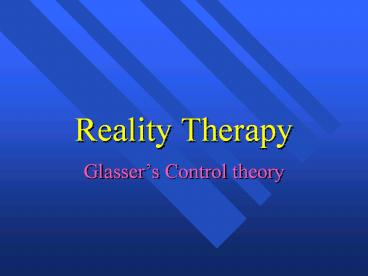Reality Therapy - PowerPoint PPT Presentation
Title:
Reality Therapy
Description:
Is it helping you get what you want? If not, what might be some other ... Acknowledge cooperative behavior w/o thanking child for responsible behavior. Phase II ... – PowerPoint PPT presentation
Number of Views:315
Avg rating:3.0/5.0
Title: Reality Therapy
1
Reality Therapy
- Glassers Control theory
2
Eight Steps
- Build a good relationship
- Examine the current behavior
- Evaluate behavior-helpful or not?
- Brainstorm alternatives
- Commit to new plan
- Evaluate results-no punish/excuses
- Accept logical natural consequences
- Dont get discouraged
3
Therapy process
- Five helpful questions
- What are you doing?
- Is it helping you get what you want?
- If not, what might be some other things you could
try? - Which idea would you like to try first?
- When would you like to start?
4
Questions for young children
- What did you do?
- What is our rule about this?
- Was what you did against the rule?
- What were you supposed to do?
- What are you going to do next time?
- Do you want to write your plan for next time, or
do you want me to write it?
5
Brief counselingand Reality Therapy
- common components
- working alliance/collaboration
- identify strengths
- active counseling techniques role play,
homework, confrontation, reframing - clear, concrete, measurable goals
6
10 Step Consultation
- What have you tried that does not work? Stop
these! - Do the unexpected
- Brainstorm what you could do that might help the
child have a better day, i.e. give choices, ask
for childs opinion, place them in helper role.
7
Phase ITry one line approaches
- Ask child to stop undesirable behavior
- Try could it be questions-goal disclosure
- Acknowledge cooperative behavior w/o thanking
child for responsible behavior
8
Phase II
- Emphasize rules agreed to previously
- What did you do?
- What was our rule?
- What were you supposed to do?
- What will you do?
9
Phase II
- Use written contract or handshake
- What did you do?
- How did it help you?
- What could you do that would help you?
- What will you do?
10
Phase III--4 Steps
- In class time-out Quiet corner--make a plan to
return to group - Out of class time-out Make a plan to return to
class - Out of school time-out Rest of the day
- Juvenile court visit, and referral to community
agency if behavior does not change
11
Person Centered Counseling
- Five basic techniques
- Unconditional positive regard
- Active listening
- Reflection
- Clarification
- Summarization
12
Ready to Learn
- Combines Rogers/Carkhuff and Adler
- Focus on the learning skills and social skills
most predictive of long term school success - Attending, listening, social/encouragment
- Uses story telling, student story retelling, and
student story telling to teach skills - Target group is grades k-2
13
Review Play Therapy packet
- Application of person centered counseling
- Tracking of behavior
- Restatement of content
- Reflection of feeling































